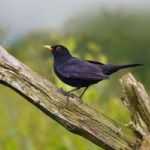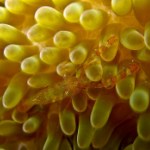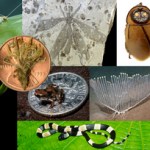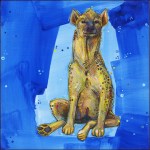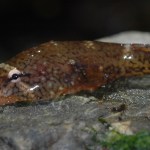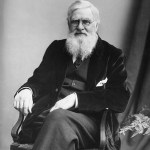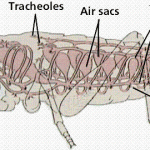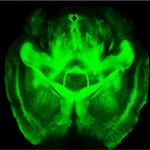Life Science
Image source: AKIKO KUMAGAI & ATSUSHI MIYAWAKI as posted in Scientific American
Dr. Miyawaki from the RIKEN Brain Science Institute in Wako, Japan and colleagues have identified the first example of a muscle protein in Japanese freshwater eels (Anguilla japonica) that fluoresces under special circumstances that may lead to improved medical testing (photo above). The researchers have isolated the protein they named UnaG (after "unagi", the term for freshwater eel in Japanese). What is unique about this protein is that it fluoresces under low oxygen conditions and when it binds to…
Dr. Liz Phular and colleagues at the University of Minnesota have been testing an experimental cancer treatment for brain tumors in dogs that also offers hope to humans with brain tumors:
KMSP-TV
Find out why most species of birds do not have a penis in this video abstract of new research published yesterday in Current Biology:
Source
Herrera AM, Shuster SG, Perriton CL, Cohn MJ. Developmental basis of phallus reduction during bird evolution. Current Biology Published online June 6, 2013. doi: 10.1016/j.cub.2013.04.062
Blackbird image from: Ernie Janes/naturepl.com
A recent study has provided some evidence supporting the hypothesis that light and noise pollution alters the biological clocks of birds living in cities (compared to birds living in rural areas).
Dr. Dominoni (Max Planck Institute for Ornithology, Germany) and colleagues used radio-pulse transmitters attached to European blackbirds (Turdus merula) living in Munich, Germany (city) and those living in a forest nearby to track the animal's activity levels. They found that blackbirds living in the city showed…
Caribbean sun anemone. Image from Wikimedia, Omar Spence Photography.
Dr. George Chandy at the University of California, Irvine discovered a toxin in Caribbean sun anemones (see photo) in 1984 and has spent his career studying the toxin. Prior work by his team suggested that a synthetic version of a peptide (ShK-186) from the toxin may help treat autoimmune disease. It works by blocking a specific potassium channel (Kv1.3) important in immune system reactivity. Since potassium channels are also important in the regulation of metabolism and body weight, his team wanted to explore…
The top 10 new species discovered in 2012 has been announced by the International Institute of Species Exploration at Arizona State University.
Tope 10 new species discovered in 2012. Image from: International Institute for Species Exploration, Arizona State University
My favorites:
The adorable tiny frog, Paedophryne amanuensis, from New Guinea that is only 7mm (pictured above on a dime). It is currently considered the smallest living vertebrate.
Glow-in-the-dark cockroaches, Lucihormetica luckae, from Ecuador (top right in composite above). Consider them night lights. Species of…
I was just digitally flipping through a new book called "Crime Against Nature", which describes various reproductive behaviors in the animal kingdom. It is written by an artist, Gwenn Seemel, not a scientist, so I cannot vouch for the scientific accuracy of the book as a whole. However, the illustrations are quite nice and the content is seemingly scandalous, which makes for an interesting read.
For example, did you know that male Dayak fruit bats can lactate to feed their young (True according to this article in Nature)?
Image from "Crime Against Nature",…
Image of atopic dermatitis from www.itchfreepet.com
Dr. Kerstin Lindblad-Toh at Uppsala University (Sweden) who specializes in comparative genomics and Dr. Åke Hedhammar, SLU (Sweden) recently identified a novel gene in German shepherd dogs, PKP-2, that encodes a protein (plakophilin-2) important for regulating proper skin structure and function. This protein was found to be associated with canine atopic dermatitis (i.e. doggy eczema), a condition that affects 3-10% of man's best friends. Researchers hope that the discovery of this gene relationship may lead to better understanding of…
A Cold War bunker at Loring Air Force Base in Maine that has been converted into a winter haven for bats. Image from: BBC News, USFWS/S. Agius
Scientists in Maine have converted two Cold War bunkers at Loring Air Force Base into winter havens for bats in an effort to protect the animals from the fungus that causes white nose syndrome. What is nice about using a man-made space is that they can actually clean up the area as opposed to trying to kill the fungus in a cave where multiple species of fungi may be affected, thereby disrupting the micro-ecosystem. The winter survival…
Clingfish (Gobiesox maeandricus).Image credit: Thomas Kleinteich
Live Science posted a story recently on the sticking power of clingfish. Northern clingfish, like the one shown in the image above, live in turbulent waters off the Pacific Coast of North America. In order to cling to surfaces, the animals have what are called adhesion discs on their bellies that they use to hold on tightly to various surfaces.
Biologist Adam Summers at the University of Washington has been studying how these fish cling to surfaces. His research team put a variety of sandpaper textures into a tank of water…
Alfred Russel Wallace. Image from: NPR, Hulton-Deutsch Collection/Corbis
Darwin is the more famous of the two when it comes to thinking about who came up with the theory of evolution. However, a man named Alfred Russel Wallace co-discovered the theory.
Alfred Wallace died 100 years ago. In honor of his contribution to the theory of evolution, NPR ran a wonderful story about him and his discoveries the other day. Just in case you did not get a chance to hear it, you can either read the transcript or listen to the story here.
Today's symposia included a session on "Integrative Cardiovascular and Respiratory Physiology of Non-model Organisms" as well as the August Krogh Distinguished Lecture.
This year's Krogh lecture was given by Dr. Stan Lindstedt from Northern Arizona University. Dr. Lindstedt is arguably best known for publishing work showing that the metabolic rate of an animal is negatively correlated with body mass. In other words, smaller animals have a higher metabolic rate than larger animals. Knowing that relationship could have saved Tusko the elephant from a whopping dose of LSD (1962, prior to the…
Another exciting day for Comparative Physiology! I just got back to my hotel after the wonderful dinner meeting overlooking the Harbor.
Of course, the research was exciting too :)
Here are the highlights from today's sessions:
Heinrich E, Bradley T. Univ California, Irvine I learned a lot about the insect tracheal system this morning. Insects do not have continuous gas exchange with environment like we do. Rather, gas exchange is discontinuous and involves valves, called spiracles:
Diagram of how insects breathe from www.breatheornot.wordpress.com
When carbon dioxide levels increase…
The Comparative and Evolutionary Physiology section held their Scholander Poster competition for young comparative physiologists today! It was exciting to see all of the students present their work.
Here are some of the highlights:
Raffaele Pilla, Dominic P, D'Agostino, Carol S. Landon, and Jay B. Dean from Molecular Pharmacology and Physiology, University of South Florida, Tampa, FL. These researchers demonstrated that a ketone body, often thought of as waste products resulting from the use of fats for energy, can have protective effects against seizures caused by exposure to…
As always, the opening ceremony for the American Physiological Society at the Experimental Biology meeting was awesome! The food was probably the best I have had at these meetings, which along with the fun band, probably explains why it was jam-packed with Physiologists eager to kick-start this meeting.
I am looking forward to the Scholander poster session tomorrow. This poster session is sponsored by the Comparative and Evolutionary Physiology section of The American Physiological Society. It is a competition in which trainees present their research in the hopes of receiving a travel award…
Image of a Giant African land snail from a Florida Department of Agriculture Division of Plant Industry handout.
Giant African land snails, like the one pictured above, are reportedly "one of the world's most destructive invasive species" as they not only consume over 500 plant species, they can actually eat stucco (apparently a good source of calcium). Therefore, I am sure you can imagine the damage they are causing in South Florida where they can grow as large as a rat. Since 2011 when the snail was first seen, more than 117,000 have been captured in Miami-Dade County.
More…
Researchers at Massachusetts General Hospital (Boston) have successfully regenerated kidneys that were unsuitable for transplantation. They stripped the tissue of all native cells, then added donor stem cells to the scaffolding that was left behind. The re-animated kidneys successfully created urine after being transplanted into rats! The hope is to apply this technique to humans with end stage renal disease who are in need of kidney transplants and reportedly would work for the regeneration of other tissues as well.
Dr. Kelly Swanson, a professor of animal and nutritional sciences at the University of Illinois at Urbana-Champaign just published an article on the topic of pet obesity in the Journal of Animal Science. His research is designed to explore how foods alter gene expression in our pets, a field called nutrigenomics. He thinks that domestication (reducing the need for animals to hunt or compete for food) may contribute to the rise in pet obesity. Since domesticated animals also spend less time and energy trying to reproduce, thanks to spaying and…
3D image of a brain made transparent using the CLARITY technique. Image from: Deisseroth Lab as posted in The NY Times
I have to admit I love the science section of The New York Times. The topic today: Dr. Karl Deisseroth and colleagues at Stanford University have developed a technique called CLARITY that uses hydrogel to make the brain look like it is made of Jell-O. They have successfully applied this technique to a whole mouse brain as well as part of a human brain. Using CLARITY, they are able to observe neuronal networks three dimensionally while…
The underbelly of a painted turtle. Image from: Tracey Haynes Photographs
Now we can add Western painted turtles (Chrysemys picta bellii) to the list of species to have their genome sequenced. The goal of sequencing their genome was to try to find genes that control the ability of these animals to survive freezing solid during the winter. Because they are not able to breathe while frozen, researchers wanted to know if any genes help make the animals more tolerant of these anoxic (without oxygen) conditions.
What they discovered were genes in the brain and heart (19 and 23 genes,…

